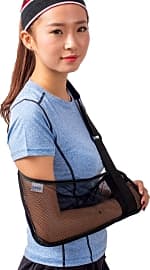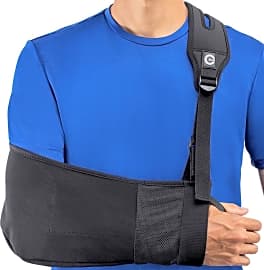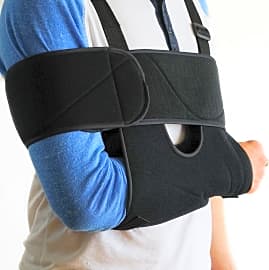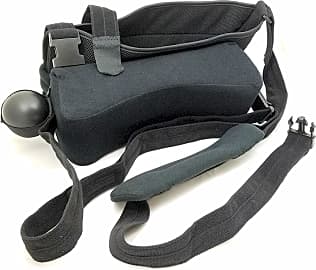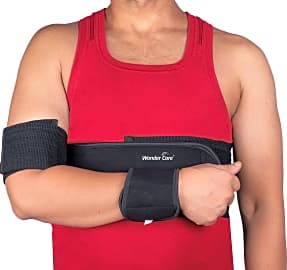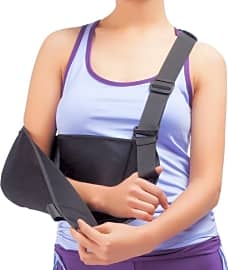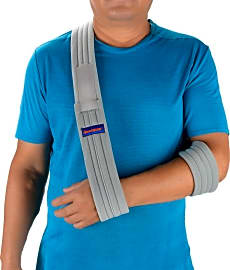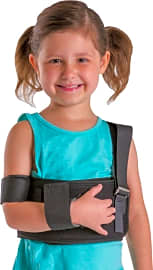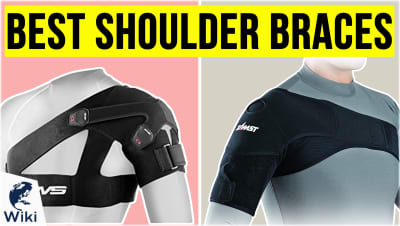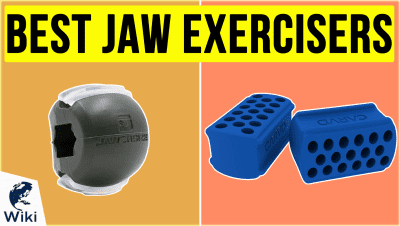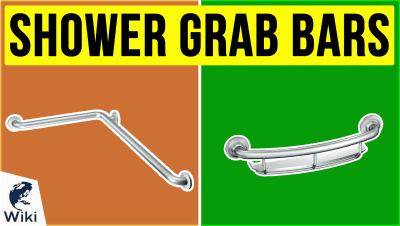The 10 Best Shoulder Immobilizers

This wiki has been updated 36 times since it was first published in October of 2016. Injuring yourself is bad enough without the additional worry of protecting your arm or shoulder during recovery. These slings are specifically designed to hold your limb in place so you don't accidentally interfere with the healing process. They come in a variety of configurations, so whether you need full immobilization or just a little extra stability, there is one here for you. When users buy our independently chosen editorial choices, we may earn commissions to help fund the Wiki.
Editor's Notes
April 20, 2020:
Whether you are dealing with an injury or recovering from surgery, it is important that you check with your doctor before assuming that any of our recommendations are suitable for you. While we have gone to extreme lengths to identify the best options available, we are not in the position to make a decision on what is right for your medical needs regarding the level of immobilization you need. However, that being said, we can certainly help you understand which options on our list offer the best stability, and which allow a little more movement.
Options like the DonJoy UltraSling IV, Flexguard Support Arm Sling, Ortho Depot Abduction Sling, Wonder Care Stabilizer, BraceAbility Pediatric 10S0101, and Velpeau Rotator Cuff Support are going to offer the highest level of stability for various reasons. For example, the Flexguard Support Arm Sling and Velpeau Rotator Cuff Support both have a large band that wraps around your arm and your mid-section, so the limb cannot move in any direction. Once you are allowed a little more movement, but still need support, you can simply forego the use of the band. The DonJoy UltraSling IV and Ortho Depot Abduction Sling also have a strap that goes around the mid-section, but it clips to the brace rather than enveloping your entire upper arm. They also hold your limb at a slight abduction, which not only do many find more comfortable, but has been shown to improve healing for various ailments. Additionally, they both have integrated therapy balls. The Wonder Care Stabilizer is interesting in that it has a minimalist design while still providing almost total immobilization. It secures to the arm at the wrist and just above the elbow and holds it tightly against the body.
The Toddobra Cool Mesh, Custom SLR Split Strap, Medized Arm Immobilizer, and Quanquer Grey offer a bit more mobility of the joint, but still keep it supported to allow for healing to take place. They all let you use your limb somewhat, since you can move it away from the body if you want to grab a lightweight object, but still reduce strain on the joint because you won't have the weight of the arm pulling against it all the time. You'll also be more conscious of having an injury, making it less likely that you try and use the arm for something you shouldn't.
Whether you live in a warm climate or are simply prone to sweating, something that many people wearing a brace tend to experience, you'll like the Toddobra Cool Mesh and Medized Arm Immobilizer, both of which are made with a lightweight, ventilated material. The Quanquer Grey also shouldn't cause much sweating, thanks to a smart design that leaves most of your arm uncovered.
Special Honors
Advanced Orthopaedics Universal 2800 Whether you need something for post rotator cuff surgery or a dislocation, the Advanced Orthopaedics Universal 2800 is a suitable option. It has a wide band that wraps around the body at the midsection and a clavicle strap, the former of which attaches to the arm just above the elbow, and the latter of which attaches to the wrist. advanced-orthopaedics.com
Donjoy UltraSling Quadrant Offering four angles of immobilization, the Donjoy UltraSling Quadrant is for anyone who cannot allow their shoulder to have even the slightest bit of movement while they heal, such as someone who has just had a full joint replacement. It can hold the arm at 15 degrees or more of abduction and, despite looking intimidating, is actually rather simple to don without help. djoglobal.com
When To Use A Shoulder Immobilizer
If you’ve ever had a serious shoulder injury, you’re well aware of how sensitive the healing process can be.
If you’ve ever had a serious shoulder injury, you’re well aware of how sensitive the healing process can be. You might not realize it until you’ve had pain in that area, but the shoulders are responsible for a tremendous amount of your upper body coordination, and any injury to that part of the body can be extremely painful, whether you’re inadvertently moving the shoulder itself or just sitting around breathing.
About five years ago I was hit from behind into the boards during a game of ice hockey, bruising the top of the shoulder and tearing two rather important tendons just behind the brink of needing surgery to repair them. The only thing I could do to help the shoulder heal and minimize pain was to take an analgesic and to keep my shoulder as still as possible.
If you’re in any similar situation, whether you’ve suffered a rotator cuff injury or you’ve found another way to damage your shoulder, you’re going to want to get your hands on a shoulder immobilizer. You’ll find it effective in a number of ways.
For starters, a good immobilizer will, as its name suggests, keep your shoulder as inactive as possible. That rest is integral to the healing of the joint, as any additional movement after an injury can cause setbacks.
Along those lines, a shoulder immobilizer will also help prevent you from making any large, reactive movements that could do real damage. This is both a practical and psychological effect. On the practical side, the immobilizer will prevent your arm from extending in a reactive manner (like when something falls in front of you and you instinctively try to catch it with your bad arm, for example). On the psychological side, having your arm pinned to your body will help your brain eliminate it as an option for reactive movements.
Shoulder immobilizers also position your shoulder in a manner that can optimize healing. If an immobilizer froze your arm somewhere above your head, it would likely take you much longer to heal, and you might even heal in the wrong way. But an immobilizer will ensure that tendons or muscles that need time to repair will do so in a manner that’s ergonomic to the natural flow of the joint, preventing the buildup of unnecessary scar tissue and helping you return to the full mobility you enjoyed before the injury.
How To Choose The Right Immobilizer For Your Injury
As you peruse the shoulder immobilizers on our list, you’re likely to notice that there are a few different styles available to you. Knowing which one is right for your injury isn’t particularly difficult, but we do recommend that, in addition to taking our advice, you double-check any decision you make with your doctor.
Once you’ve decided on a style, you’ll want to investigate the material quality and breathability of a given model.
The clearest difference among the immobilizers on the market is the way that they attach to the body. Some options simply wrap tightly around the torso. These keep all of the weight of the injured arm on your hips and lower back, so there’s no drag on your shoulders. This is especially nice if you have a major injury to one shoulder, and a minor injury to another, as it won’t cause any unnecessary pain.
Other options on the market resemble traditional slings, but they may have additional means to keep the arm and shoulder still. The great advantage of these is that they won’t slip below the ideal healing position like torso-only models might, and they don’t have to be tightened around your stomach, making them both more comfortable and potentially better for healing.
Once you’ve decided on a style, you’ll want to investigate the material quality and breathability of a given model. If you have any sensitivity to certain fabrics, make sure that the option you’ve got your eye on doesn’t contain any of them. Certain materials will breathe better than others, as well, and you might find an immobilizer particularly uncomfortable in a humid climate if it doesn’t breathe well.
The last variable you might want to consider is appearance. It may seem shallow at first to approach an implement like this with an eye toward fashion, but there is some wisdom here. Shoulder injuries are among the most frustrating for their pain level and ability to keep you out of action. Any advantage you can gain in the healing process — even if it’s one gained from feeling better about the way you look in your immobilizer — might make a positive difference.
A Brief History Of Immobilization
You probably heard it pretty early on in your life, especially if you were a rambunctious or athletic child who suffered an injury or two: the healing process requires rest, ice, compression, and elevation. The first item on that list is what shoulder immobilizers concern themselves with, but the history of the technique far predates your first childhood injury.
The first item on that list is what shoulder immobilizers concern themselves with, but the history of the technique far predates your first childhood injury.
The evidence of that development comes to us in the form of an ancient document from Egypt. The Edwin Smith Papyrus — named for the man who discovered it, not for an ancient Egyptian with a suspiciously Anglican name — is a long medical text that exemplifies the impressive amount of anatomical knowledge that the Egyptians had amassed.
Those early Egyptian texts suggested cotton wraps as a means of immobilization, and cloth of varying materials was the primary way to keep limbs still during the healing process for the next several millennia. The use of wood and leather in the creation of splints and similar immobilization devices was fairly common, as well, though simple cloth was more commonplace, especially among the lower classes who were more strapped for spare materials.
Today, there are plenty of natural and synthetic materials for manufacturers to choose from. These help immobilizers keep their shape after weeks of use, and even stand up to the rigors of multiple injuries. The means for fastening modern implements are far superior, as well, with Velcro being among the most popular options.


